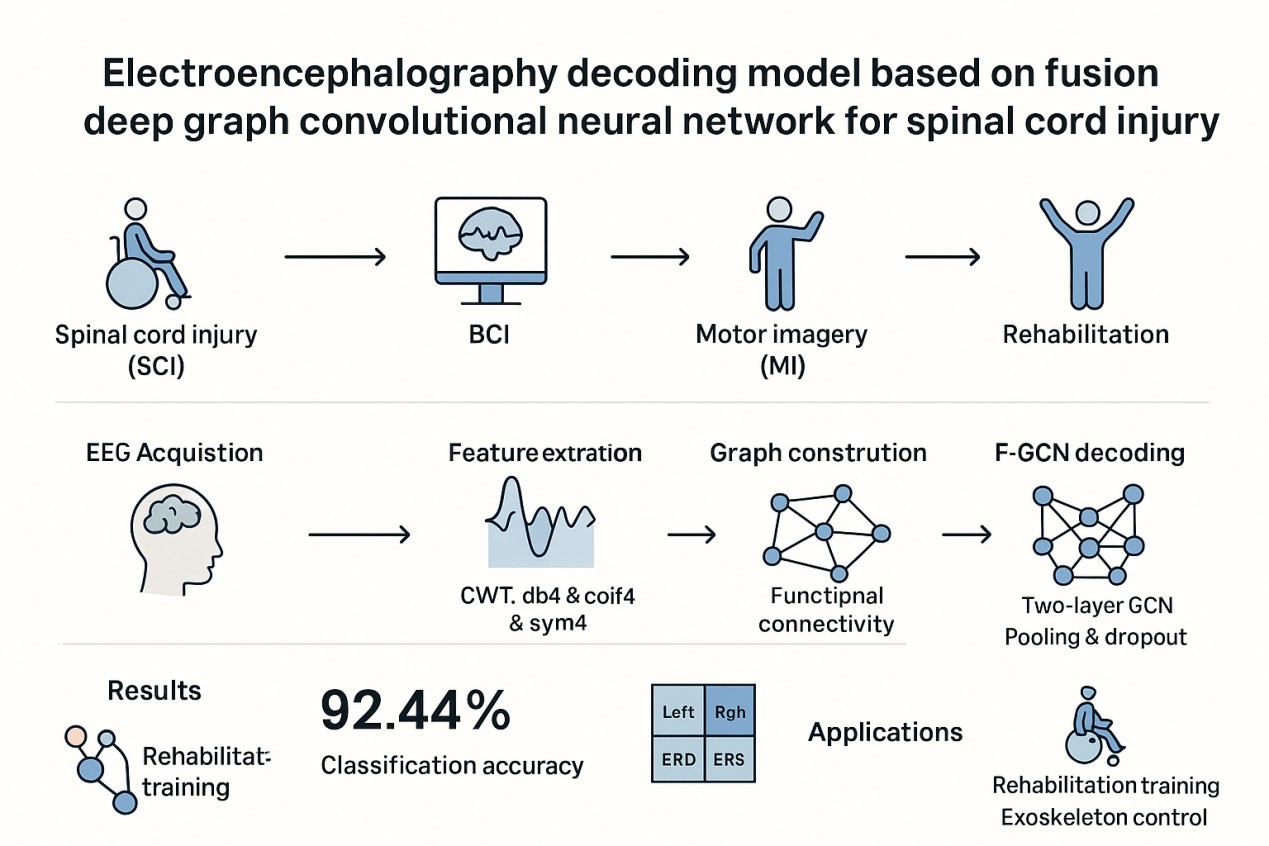AI Analyzes Brainwaves to Unlock Movement in Spinal Cord Injury Cases
Published 21 October, 2025
Spinal cord injury (SCI) refers to impact of trauma or illness on the spinal cord, causing motor, sensory, and autonomic dysfunction below the injury level. The cause of injury determines whether it is a traumatic SCI (tSCI) or a non-traumatic SCI. As society progresses, the incidence of SCI cases in clinical settings is on the rise. However, current clinical application of symptomatic drugs and surgical treatments has not yielded satisfactory outcomes.
In a new study published in the KeAi journal Healthcare and Rehabilitation, a team of researchers from China proposes a deep learning framework, fusion graph convolutional neural network (F-GCN) that integrates multiple wavelet bases for the recognition of motor imagery (MI) electroencephalogram (EEG) signals.
“By modeling the functional topological relationships between electrodes, it extracts features that reflect the intention of the MI task,” shares first author Tianwei Lou.
Experimental results show that the model with fused features achieves an average prediction accuracy of 92.44%, which is significantly better than the features of a single wavelet basis (coif4: 67.67%, db4: 82.93%, sym4: 73.10%). Moreover, it demonstrates good stability and individual convergence in leave-one-out cross-validation, verifying the rationality and effectiveness of the feature extraction method.
To date, several studies have suggested that brain-computer interface (BCI) technology utilizing motor imagery (MI) could assist in the recovery of motor functions for SCI. The core of the BCI system is to obtain effective features to evaluate brain function by analyzing the electroencephalography (EEG) signal of MI. The concept of MI states that when someone imagines moving different parts of their body, the functional areas of their brain are activated, resulting in unique EEG signals.
Notably, preliminary studies have shown that spinal cord injury patients could operate an EEG-based MI-BCI system as effectively as healthy subject — how to correctly analyze the MI of spinal cord injury patients is very important in the rehabilitation of patients. “However, MI-EEG signals have a high-dimensional structure, processing and decoding this intricate EEG data requires sophisticated machine learning and deep learning methods,” says Lou.
According to co-corresponding author Yang Zhang, the team's F-GCN demonstrates good scalability and clinical application potential. “It's able to extract individualized brain functional topological structures and achieve high-precision classification,” says Zhang. “It may be used in brain-machine interface systems, such as rehabilitation exoskeletons and neural feedback devices, to provide stable command output for SCI patients.
“Considering that there may be electromyogram (EMG) artifacts during the MI process, future studies will introduce combined EEG-EMG monitoring and ICA techniques to improve signal quality and decoding robustness, and enhance the clinical applicability of the model in rehabilitation,” adds Lou.

Funder:
The author(s) declare financial support was received for the research, authorship, and/or publication of this article. The project is supported in part by the Fundamental Research Funds for the Central Universities (No. 2022JC013), the Natural Science Foundation of Shandong Province of China (No. ZR2021MH023), the Program for Youth Innovative Research Team in the University of Shandong Province in China (No. 2019KJN010), the Introduce Innovative Teams of 2021 “New High School 20 Items” Project (No. 2021GXRC071), the Clinical Research Cross-Project of Shandong University (No. 2020SDUCRCB004), the National Natural Science Foundation of China (No. 82172535), Key Program of the National Natural Science Foundation of China (No. 82330064), Natural Science Foundation of Shandong Province (No. ZR2022MF289), National Natural Science Foundation of China (No. 62271293), Graduate Education and Teaching Reform Project of Qilu University of Technology (Shandong Academy of Sciences) in 2023, and Talent Training and Teaching Reform Project of Qilu University of Technology in 2022 (No. P202204). Research and Innovation Team Project of Shandong University of Traditional Chinese Medicine Affiliated Hospital (No. 202472).
Conflict of interest:
The authors declare that the research was conducted in the absence of any commercial or financial relationships that could be construed as a potential conflict of interest.
See the article:
Tianwei Lou, Xinting Zhang, Lei Jiang, Lei Chen, Licai Gao, Zhixiao Lun, Jincheng Li, Yang Zhang, Fangzhou Xu, Tzyy-Ping Jung. Electroencephalography decoding model based on fusion deep graph convolutional neural network for spinal cord injury, Healthcare and Rehabilitation. 2025; 1(3): 100039. https://doi.org/10.1016/j.hcr.2025.100039